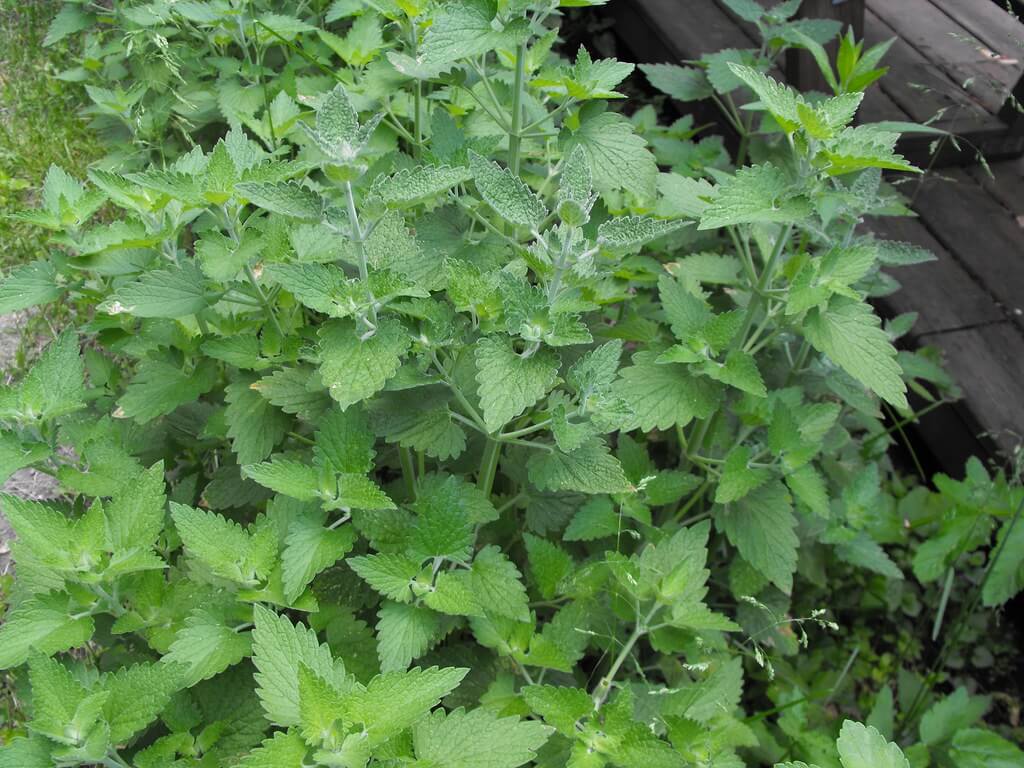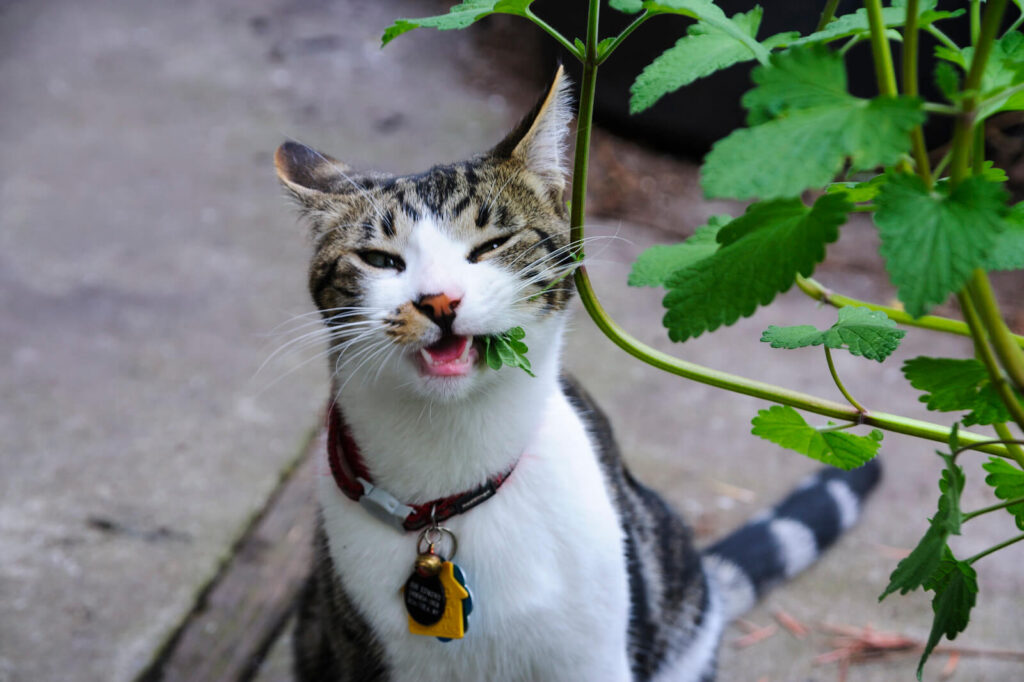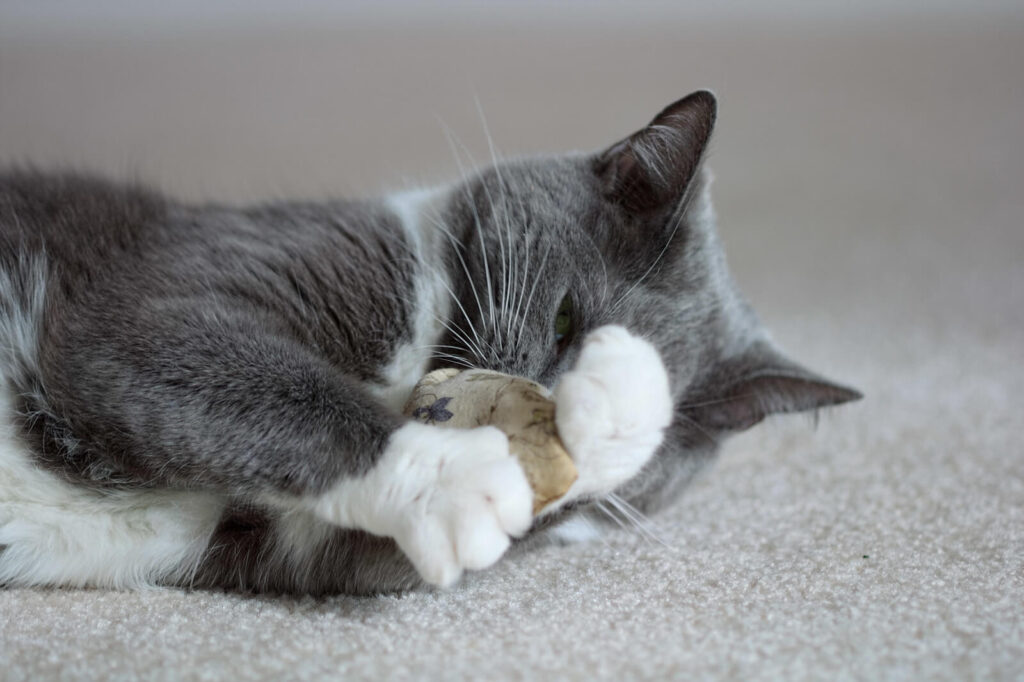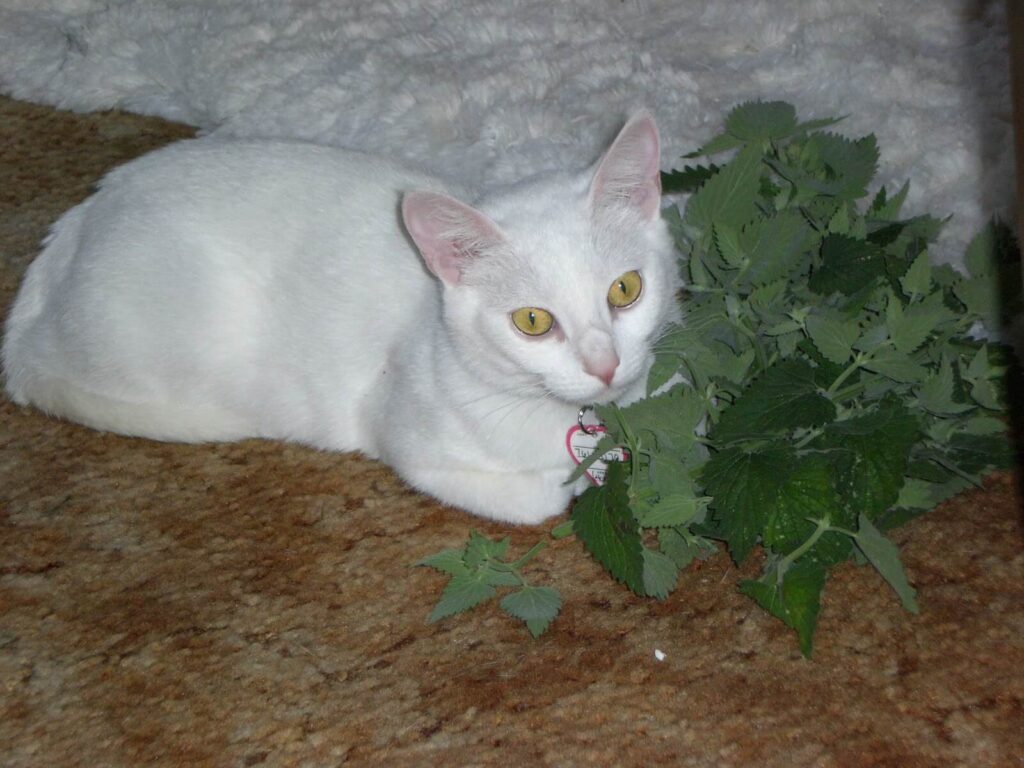Exploring The Best Views of What Does Catnip Look Like
Introduction
Cats enjoying catnip often display a sense of pure bliss – rolling, rubbing, and luxuriating amongst the aromatic leaves and flowers. This minty herb elicits a euphoric response in many domestic cats when they sniff, eat, or roll on it. But have you ever gotten close enough to really examine its leaves, stems, and flowers and appreciate their distinct characteristics? “What Does Catnip Look Like?” is a common question among pet owners, as they seek to identify the distinctive heart-shaped leaves of this herb.
While people don’t experience effects from catnip like our feline companions, we can still enrich our understanding of this beloved stimulant. The appearance and growth patterns of the Nepeta cataria plant reveal how it has captivated cats for centuries. What does catnip look like? It’s a question often answered with images of vibrant green, serrated leaves.
In this article, you’ll gain a deeper appreciation for the visible properties of catnip. We’ll navigate the geometry of the leaves, the color gradients of the flowers, the texture of its foliage, its growth stages, and how to distinguish it from look-alikes. You’ll discover distinguishing traits to spot when foraging for cat bliss helpers. Understanding what a catnip looks like aids in identifying it and harvesting and cultivating it. Understanding “What Does Catnip Look Like?” becomes easier when you recognize its slender stems adorned with clusters of tiny, white flowers.
Let’s explore why so many cats go crazy for this fascinating member of the mint family. By examining photos and descriptions, you’ll learn to recognize emerging shoots, flowering tops, and dried material. Join me on a tour of this beloved plant’s aesthetic magic.
What Does Catnip Look Like?
Have you ever stumbled upon a wild cluster of plants that makes nearby cats go crazy? Chances are, you’ve encountered catnip in the wild. The catnip plant (Nepeta cataria) is a member of the mint family with signature features that give away its identity to knowing eyes.
Exploring “What Does Catnip Look Like?” reveals a plant with serrated, green leaves that exude a pungent aroma when crushed.

When fully grown, the catnip plant has:
- Green leaves with scalloped edges and a downy, soft texture
- Oblong or heart-shaped leaves up to 2 inches long
- A hairy, fluffy appearance thanks to tiny hairs on stems and foliage
- Glossy leaves that are fragrant when rubbed or crushed
- Stout stems that grow upright to 3 feet tall for support
- Clusters of white or light purple flowers at the tops of stems
The small, tube-shaped catnip flowers have 5 oval petals each. They bunch together in dense whorls stacked atop one another like tiers on a cake. This forms the familiar flower spike shape many mints display.
Delving into “What Does Catnip Look Like?” leads to the discovery of its characteristic square-shaped stems and soft, fuzzy texture.
Fun Fact: The scientific name Nepeta cataria contains “cataria” as a nod to its allure for cats. In many ways, cats have claimed this member of the mint family as their own!
Anatomy of a Catnip Plant
Getting acquainted with parts of the standard catnip plant will help you recognize it. Here’s an overview:
- Roots – Fibrous root ball structure like many mints
- Stems – Square, rigid stems covered in fine hairs. Grow 1-3 feet tall.
- Leaves – Heart/arrowhead-shaped green leaves in pairs along the stem
- Flowers – Tubular light purple flowers clustered into flower spikes
- Seeds – Tiny brown teardrop-shaped seeds that assist reproduction
Now that you know the signature attributes of catnip’s foliage, floral displays, and growth structure, you’ll recognize it from other mints. Let’s see how catnip compares to its popular minty cousins…
Discerning “What Does Catnip Look Like?” involves noticing its vibrant green foliage, which often grows in bushy clumps.
How to Distinguish Catnip From Other Mint Plants
Catnip belongs to the aromatic Lamiaceae family, along with well-known herbs like peppermint, spearmint, oregano, basil, thyme, and more. Many mint family members share similarities since they derive from a common ancestor. But catnip has a few key differences that set it apart from even its closest botanical cousins.
Investigating “What Does Catnip Look Like?” uncovers its resemblance to common mint plants, with jagged edges on its leaves.
When examining an unknown mint, check these ID points to discern whether it’s catnip or an imposter:
Leaf Appearance
| Characteristic | Catnip | Spearmint | Peppermint |
| Shape | Heart/arrowhead | Long & pointed | Serrated oval |
| Color | Green with purple accents | Bright medium green | Dark forest green |
| Texture | Soft, fluffy | Smooth, shiny | Smooth with indented veins |
Notice catnip’s distinctive heart-shaped form and downy texture – no other common mints share this exact leaf appearance. The purple coloration is another clue; spearmint and peppermint lack reddish hues.
Scent
Crush a small leaf and take a whiff. Catnip has a minty, herbaceous fragrance reminiscent of oregano, thyme, or sage. Spearmint and peppermint, by contrast, give off sharper, brighter aromas heavy on the mint. Catnip’s softer, subtler scent aligned with its cat-alluring compounds.
Contemplating “What Does Catnip Look Like?” brings to mind its distinctive scent, which attracts feline friends far and wide.
Growing Behavior
Catnip acts similarly to invasive mints, spreading aggressively by above and underground stems called rhizomes. But you’ll notice catnip isn’t as eager to take over an entire plot as aggressive mints, including lemon balm, horsemint, and field mint, if it seems contained or pitiful in its clumping and spreading, that hints towards catnip.
With attention to these aspects, identifying catnip becomes much easier. Pay special notice to the iconic leaves and restrained growth tendencies. And when in doubt, wave a branch under your resident cat’s nose!

Demystifying Catnip Flowers: What Does Catnip Look Like?
Catnip intrigues cats with its cluster of pale purple flowers bursting with stimulating scent compounds. These bloom atop rigid stems several feet tall, attracting feline attention. But if you peek closely at catnip flower anatomy, you’ll notice intricacies beyond its kitty-pleasing fragrance.
Answering “What Does Catnip Look Like?” reveals a plant that thrives in sunny locations with well-drained soil.
Catnip forms dense, brushy flower spikes consisting of many small tubular blossoms. Blooming occurs from late spring through fall.
Let’s examine details of the formation, structure, coloration, and other traits of these flowers that complete the catnip plant’s lifecycle:
Flower Structure Breakdown
- Petals: 5 oval, delicately veined petals
- Shapes: Individual flowers tube-shaped with straight walls and slightly flared rims
- Size: Approximately 1⁄2 inch long flowers
- Arrangement: Flowers clustered tightly into tiered whorls stacking along spikes
- Stamens: 4 long white stamens protrude from each flower, tipped with yellow anthers
Timeline of Growth
Catnip flowers originate as green early-stage buds at the tips of stern, square stems. As they mature, these knobby buds swell and transition to a whitish color. Eventually, the petals unfurl to reveal pale purple hues. Full flower spikes last for around 6 weeks.
Transition of catnip flowers:
- Closed green buds
- Enlarged whitish buds
- Flower spike with purple tint
- Full flower spike bloom period
- Seeds begin dispersing
Color Spectrum
The color of catnip blossoms can vary slightly depending on growing conditions and specific genetics:
- White
- Very light lavender
- Light purple
- Purplish pink
You’ll never spot bright pinks, reds, or blues – they stay softly tinted along a narrow pastel color palette.
Fragrance
Crush a catnip flower between your fingers, and you’ll notice they share the signature minty aroma of the leaves and stems at an even more concentrated level. This is why cats bliss out snuffling and chewing the flower tops!
Now that you know what defines catnip’s delicate flowers, you can admire them as more than just a kitty treat. Their details reveal nature’s clever designs to lure helpful pollinators as well.

Following Catnip From Sprout to Flower: Growth Stages
Catnip transforms dramatically from a tiny seed to a towering flower spike. Tracing this process reveals the resilience of a plant specifically tailored to charm cats across every phase of development.
Emerging from seed, miniature green shoots signal life from dormancy. Let’s track progress through maturation as stems stretch, foliage fills out, and finally, alluring blossoms cap it all off:
Sprouting
Catnip seeds germinate under the right conditions of moisture, warmth, and soil contact. First, a tiny root emerges, growing thicker over several days to anchor the seedling. Next, the first embryonic leaves unfurl – miniature versions of the mature leaf shape with a lighter green color. Two leaves comprise the initial set. The small plant sustains itself as the root system expands downwards to absorb nutrients and moisture.
Pondering “What Does Catnip Look Like?” highlights its preference for temperate climates, where it can reach heights of up to three feet.
Leaf Production
Once rooted and able to synthesize energy from light via photosynthesis, vertical growth accelerates. The initial two leaves make way for several pairs along an extending central stem. More foliage leads to more energy absorption; nip has high needs as an aromatic plant filled with potent essential oils. The leaves gradually mature to standard size. Rough hairs begin covering new growth.
Stem & Branch Formation
After 5-6 pairs of leaves emerge, catnip bolts upward, rapidly elongating its main stem. The central stem becomes woody and square-shaped. Smaller side shoots also emerge from leaf axils, creating a bushy, branched form. Flower buds begin forming where newer branches fork from older ones.
Flowering
Within about 8 weeks of first emerging, catnip reaches the flowering stage under ideal conditions. The white knobs of developing blossoms mature into the familiar tubular flower clusters. Blooming progresses up and down the spikes for several weeks, replenishing spent flowers. The plant devotes energy to seed production, dispersing genetics far and wide – or into your fascinated cat’s mouth! Seeds then enable the cycle of growth to begin anew.
Now you can recognize catnip by growth phase – and know what to expect as you track its development from seed to enticing fragrant flower spike.
What Does Catnip Look Like: Appearance and Uses
Cat owners don’t need to grow fresh catnip to provide the intoxicating herb year-round. Dried catnip retains its essential oils and aromatic qualities if stored properly, allowing longer-term stimulation even through winter months when outdoor plants decline.
Reflecting on “What Does Catnip Look Like?” evokes images of its delicate flowers blooming from late spring to early autumn.
What Does Catnip Look Like? – Catnip plants boast jagged, toothed edges on their leaves and a distinct minty aroma.
Dried properly, catnip foliage assumes a faded green, greyish color. The leaves and flowers become crispy and crumbly in texture, brittle to the touch yet still releasing fragrance when crushed. You’ll notice some subtle purple hues in certain light. The stems also dry and harden but generally get discarded before packaging the leafy parts.
Forms of dried catnip:
- Loose dried leaves
- Crumbled/cut pieces and flowers
- Entire dried stems
- Contained in cat toys, often little cloth bags
- Catnip sprays (essential oils without plant material)
Keep dried bundles in sealed, airtight containers out of sunlight to preserve aromatic potency. As long as it gives off a signature minty scent when squeezed and hasn’t turned brown or moldy, dried catnip remains effective for feline enjoyment through all seasons!Ever asked yourself what does catnip look like? Visualize fresh, green foliage with distinctive jagged edges.

Catnip Look-Alikes: Avoiding Imposters
When seeking or cultivating catnip, exercise caution to avoid non-nip plants that resemble but lack special cat-stimulating qualities. These imposters, also mints, won’t induce the beloved catnip’s blissful state of euphoria.
Common Catnip Substitutes
Catmint (Nepeta cataria) – Close genus but different species. Milder reaction in cats. Leaves less heart-shaped.
Lemon balm – Very similar leaves but with a citrusy scent. Lower plant with smaller white flowers.
Russian sage – Shares some aromatic qualities but isn’t mint family. Woody stems and purplish flowers differentiate it.
Sweet woodruff – Fragrant leaves elicit little to no cat interest despite some visual and scent similarities when crushed.
Avoiding the Purchase of Fake Catnip
When buying dried catnip, inspect it closely and give it a sniff test. Real catnip has a smooth, greenish-gray color when dried, with no clumping or spots. Rubbing a leaf between your fingers should instantly release that sharp, penetrating signature mint/citrus aroma. If the scent seems “off” or weak, it may not elicit cat euphoria and likely won’t be the real deal.
Wondering what does catnip look like? Imagine lively green leaves, textured and fragrant, enticing feline interest.
With attention to detail on key identification markers, you’ll be able to recognize authentic fresh and dried catnip to keep the bliss coming for your feline fanatics. Know the look and aroma so you don’t get fooled by mimics!
Conclusion: What Does Catnip Look Like
From first glimpse to fully blooming, catnip intrigues through every phase. Now, when you come across this plant in backyard gardens or out in nature, you’ll spot telltale identification points of the leaves, stems, growth patterns, and delicate flowers. You’ll recognize why the appearance and scent spark such delight in cats across the board.
What Does Catnip Look Like? – Catnip appears as a bushy, green herb with a penchant for attracting felines with its potent scent.
The heart-shaped leaves, bushy flowering tops, and scalloped-edge foliage signify the Nepeta cataria species specifically geared by evolution for cat seduction and seed dispersal. While humans can’t experience the euphoric effects firsthand like cats, we can still appreciate catnip’s alluring bouquet, stimulate our pets with it, or even add leaves to teas for mild relaxation benefits of our own. What Does Catnip Look Like? – Catnip showcases slender stems adorned with clusters of aromatic foliage.
What Does Catnip Look Like? – Catnip displays delicate, white-flecked petals amidst its lush greenery.
So keep an eye out around yards, meadows, and trails for these green mounds of delicate leaves paired along square stems. Stop and admire the purple accents of the leaves and light lavender flowers when spotted. Consider adding a catnip plant or two to your garden for the viewing and sniffing pleasure of neighborhood cats!

